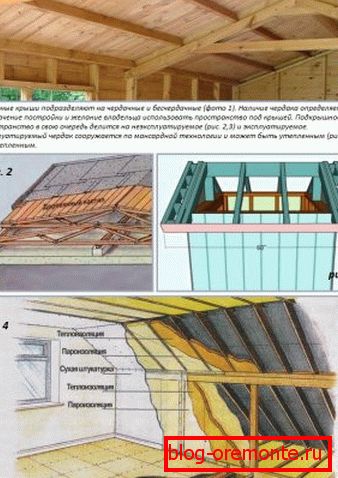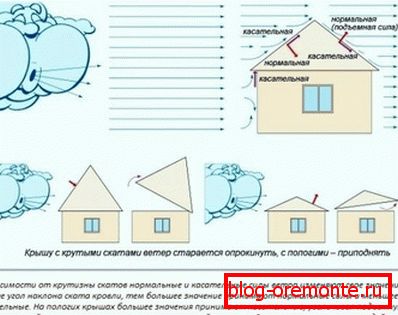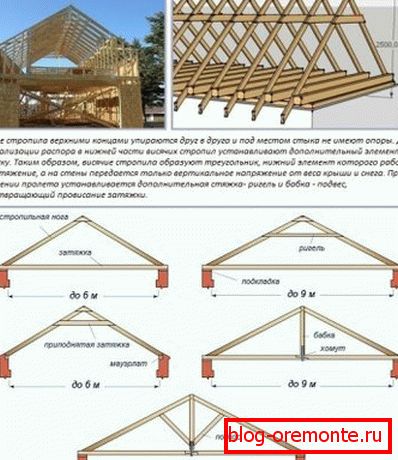Roof rafter system - structure, devices and types
Roof structures are one of the most complex in the design and installation of residential building components. The roof first assumes the “blow”, protecting the house from precipitation, wind and cold, so the comfort of all households depends on its tightness, durability, quality. The basis of a reliable roof is the truss system, which gives shape to the structure, sets the optimum slope, and also serves to fix the waterproofing material. The composition and relative position of the frame elements depend on the roof configuration. In this article we will describe what types of roof systems are, as well as how they differ from each other.
Functions
Rafter system - a set of supporting elements that support the geometry of the roof, the frame of the roof structure, giving it rigidity, the desired slope. The composition, thickness of the section, the location of the parts of the “backbone” of the roof are determined using calculations that take into account permanent and temporary loads. The roof frame performs the following functions that determine the functionality of the roof:
- Sets the geometry, slope. The rafter legs of the frame give the roof the necessary angle of inclination and shape, facilitating the ease of snow or precipitation from the surface. It depends on the frame how many tongs or ramps will have a roof, which means this element of the structure determines its appearance.
- It serves as a basis for attaching a waterproofing material. The trunking of the truss frame is used to fix the roof finish.
- Evenly distributes the weight of the roof. The interconnected elements of the truss system are evenly distributed, and then redirect the load from the finish coating and the weight of the snow mass between the load-bearing walls of the structure, avoiding distortion or deformation of the structure.
- Provides the functioning of the roof. The structure of the frame, taking into account the features of the roof and roofing, provides support, aeration and protection from condensate.
Consider that a well-designed roof system is a guarantee of durability, reliability and mechanical strength of the roof, so its design and installation is trusted by professional architects. Experienced craftsmen believe that high-quality frame is much more important than the finishing roofing, so you should not save on it.

Criterias of choice
The device truss system is characterized by a large number of auxiliary elements and increased complexity. It is compiled according to the calculation of permanent and temporary loads acting on the structure, the project, taking into account the selected roofing material, as well as environmental factors. When choosing the type of truss frame, the following criteria are taken into account:
- Climatic conditions in the region where construction is underway. In order for the roof to withstand the weight of snow and water during heavy rains, the average annual rainfall in winter and summer is determined.
- Wind load. To select the optimum roof design, the prevailing wind rose in the construction area is determined, and the average speed of the wind gusts is also taken into account.
- The nature of the use of space under the roof. At this stage, it is determined whether a residential attic will be equipped in the roofing room or an unheated attic.
- A variety of topcoat. For each material, the optimal angle of inclination of the slopes is calculated, taking into account its shape and method of attachment.
- The developer’s budget. The rafter system is one of the most costly in terms of material and work, part of the roof construction, therefore the type of financial capabilities of the developer determine the look.
Experienced craftsmen believe that it is useless to fight with nature, you will still lose out, therefore the climatic conditions in the area where construction is underway are of paramount importance when choosing a roof frame. If the region is windy, then the slope of the slopes is flat, and if it is snowy, it is steeper.



Materials
The rafter system is an indispensable element of pitched roofs of any shape and configuration, consisting of vertical supports, horizontal puffs and rafter legs, providing support and reliable fastening of roofing material. The material used for the manufacture of the frame must have a light weight, high strength, bearing capacity, as well as resistance to moisture. The most suitable options are considered:
- Wood. Wood is a natural, environmentally friendly material that is lightweight and durable. For the manufacture of the frame used bars of square section 100x100 mm or 150x150 mm, boards with a section of 50x150 mm solid rocks. A significant disadvantage of wooden frame elements is that they bend under their own weight with a large length, and also have a low resistance to moisture.
- Metal. Metal truss systems are more expensive than wooden ones, they are used mainly with a large ramp area and a large weight of roofing material. The high bearing capacity of the metal profile or angle allows you to increase the step between the frame elements without loss of structural strength. To reduce the likelihood of rust, apply corrosion-resistant types of metal.
Note! Wood is considered the most suitable material for the manufacture of the rafter frame of residential buildings, as it has 3 important qualities: light weight, strength, breathability. To increase the resistance of wood to moisture, it is necessary to treat the elements of the truss system with a deep-penetrating antiseptic.
Device
The device of the roof truss system consists of a set of interconnected elements, which, supporting each other, give the structure rigidity, necessary strength, and also distribute the weight of the roofing material evenly between the supporting supports. The composition of the frame, the size of the cross section of individual elements and their placement depend on the type of finishing coating, the slope of the slope and the method of using the roofing space. Usually the frame consists of:
- Mauerlata. Mauerlat is called a subrafter, which is mounted on top of the upper crown or a series of load-bearing walls of a house. It is made from durable, hardwood softwood. Attach the mauerlat with long metal studs or anchor bolts.
- Lying down A lounger is called a power beam, located not on the external load-bearing walls, but on the internal partitions. On the ground are installed central pillars supporting the roof ridge.
- Racks. Racks are called vertical support elements that support the ridge girder or the central part of the frame's truss legs.
- The rafter. Rafter legs are based on the mauerlat and ridge girder, located at an angle to the base of the roof.
- Rigel and tightening. These terms are called the horizontal elements of the frame, which together are pairwise truss legs. The crossbar is located at the top of the rafters, right under the ridge, it is thicker and stronger than the tightening that is located much lower.
- Strut The strut is set at an angle to the rafters to prevent them from bending under its own weight. At one end they rest against the leg, and with the other, against a rack or a puff.
Important! The simplest truss system consists only of a power plate, rafters and a ridge girder. With the increasing complexity of the roof increases the number of additional elements, reinforcing the structure, as well as compensating for the load on deflection and expansion.

Kinds
The configuration of the roof frame depends on the architectural features of the overlapping structure. The roof should take into account the number of bearing piers inside or outside the house in order to evenly distribute the load placed on them. There are the following types of rafters:
- Outcast. Sidewall rafters are called the frame of the roof, which relies on both external load-bearing walls and internal ones. In the role of internal pores can be a series of columns or a capital partition between rooms, provided for by the project. Additional internal support is used as support for the ridge run. With the help of slat stops, it is possible to block large area structures without losing rigidity.

- Hanging. Hanging rafters have support only at one point - at the junction with the Mauerlat. At the other end they lean on each other without the support of a ridge girder. Such a system is suitable for structures that do not provide for an internal main wall. Rafter trusses of this type have a stable shape in the form of an equilateral triangle, and therefore do not need stabilizing elements.

Note that the final form of a truss frame of wooden or metal elements depends on the number of ramps and the type of roof. The simplest options are considered to be single-pitch and dual-pitch roofs, and complex ones are hip, semi-flank, and hip roof.

